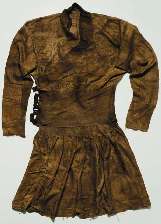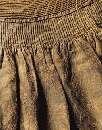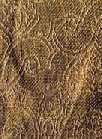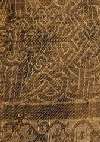|
Last Page Update:
November 16, 2001
Contact
Copyright Information
Main Page
Structure of the Red Kaganate
Gatherings, Events,...
Historic Steppes Tribes
Legends of the Nomads
Flags and other Identifiers
Clothing and Apearance
Food and related Matters
Armour
Archery
Weapons and Combat
Public Forum
Resource Links
Email:
[email protected]
Editor:
Norman J. Finkelshteyn
|
13-14th century Turco-Mongol-Persian Crossover Coat
From Christie's Auction House in London
Commentary and photos by courtesy of the Christie's web site http://www.christies.com
A Mongol Silk Lampas Weave Robe
Eastern Iran or Central Asia, late 13th or first half 14th century
Sale Details:
Sale Title ISLAMIC ART AND MANUSCRIPTS
Location London, King Street Sale Date Oct 16, 2001
Lot Number 256 Sale Number 6497
Estimate 100,000 - 140,000 British pounds
The silk woven with an intricate design of interlaced strapwork overlaid by roundels enclosing cusped oval panels of dense floral motifs around similar plainer medallions, changing on the shoulders to a design more closely imitating knotted kufic inscriptions, applied lapel panel around the collar, the waist with applied band of braiding tying at the side with ribbons, a few areas of restoration.
51�in. (131cm.) high
Lot Notes: This is one of the most complete Mongol robes to have been discovered to date. It is enormously informative as to the precise method of construction of the robe; the way the belt panel is applied over the gathered ground material and tied at the side, and the way the skirt is pleated along the upper edge. Other fragmentary robes have appeared on the market, in less complete form.
It demonstrates clearly the positioning of the different patterning in the material. The original material was woven, like a number of contemporaneous textiles, with a band of decoration along one side which was originally based on the idea of a kufic inscription. This has been used in this robe along the shoulders. It has not been used, in contrast to what one might have predicted, across the upper arms, in the position where tiraz bands are frequently depicted in miniatures.
A number of scholars have written recently on the subject of Mongol silks (particularly Wardwell, Anne E.: "Panni Tartarici: Eastern Islamic Silks woven with Gold and Silver, 13th and 14th Centuries" Islamic Art, III, New York, 1989, pp.95-173; and Watt, James C.Y. and Wardwell, Anne E. When Silk was Gold: Central Asian and Chinese Textiles, exhibition catalogue, New York, 1997). This is in part due to the number which have come onto the market recently with a Tibetan provenance. Studies have concentrated on the structure and on the origin of the designs. Origins have been suggested from very widely varying regions; there seems little hard fact on which to base an opinion. In one discussion of the group in the David Collection, Copenhagen, many pages are spent going through the various points at the end of which the author admits it is difficult to draw a conclusion as to which precise weaving centre produces each design and technique (Folsach, Kjeld v. and Klebow Bernsted, Anne-Marie Woven Treasures - Textiles from the World of Islam, Copenhagen, 1993, pp.44-64).
The main feature of the design of the present textile is the continuous interlaced strapwork; in contrast to most of the other textiles the
borders have taken centre stage, dwarfing the motifs in the middle of
the medallions. The idea of linked border strapwork is frequently
found in the Islamic world, notably in some of the metalwork of the
12th and 13th centuries. Like so many other of the textiles
acknowledged to be related, this shows a combination of influences:
Islamic borders enclose medallions which on their own would be more
Chinese in feel (for earlier similar Chinese medallions see Watt and
Wardwell, op.cit, no.33, pp.122-3). It is interesting to compare
Ming Dynasty robes such as that excavated in Zou Xian County, catalogue number 277, Chinese Costumes, Part II, 5000 Years of Chinese Art, published by the Editorial Committee of '5000 Years of Chinese Art', Beijing.
This robe has an added feature noted in a number of the Islamic Mongol lampas weave textiles: running along the upper edge of each panel is a separate design originally loosely based on kufic calligraphy. In the present textile , as also evidenced in the field, the designer must have been fascinated with interlace patterns and has allowed central knots on the verticals to take over.
|



